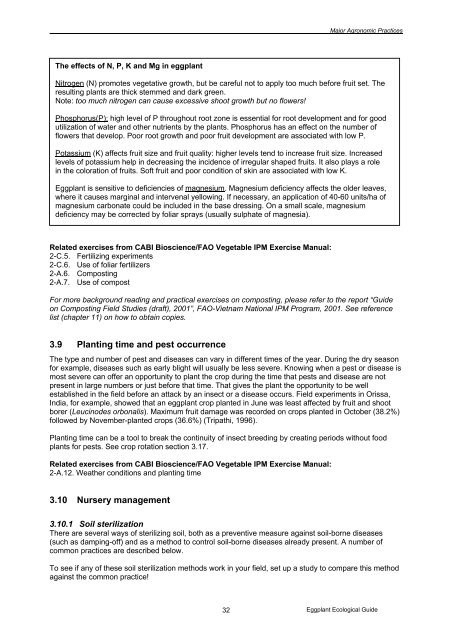Eggplant Integrated Pest Management AN ECOLOGICAL GUIDE
Eggplant Integrated Pest Management AN ECOLOGICAL GUIDE
Eggplant Integrated Pest Management AN ECOLOGICAL GUIDE
Create successful ePaper yourself
Turn your PDF publications into a flip-book with our unique Google optimized e-Paper software.
___________________________________________________________________________________Major Agronomic PracticesThe effects of N, P, K and Mg in eggplantNitrogen (N) promotes vegetative growth, but be careful not to apply too much before fruit set. Theresulting plants are thick stemmed and dark green.Note: too much nitrogen can cause excessive shoot growth but no flowers!Phosphorus(P): high level of P throughout root zone is essential for root development and for goodutilization of water and other nutrients by the plants. Phosphorus has an effect on the number offlowers that develop. Poor root growth and poor fruit development are associated with low P.Potassium (K) affects fruit size and fruit quality: higher levels tend to increase fruit size. Increasedlevels of potassium help in decreasing the incidence of irregular shaped fruits. It also plays a rolein the coloration of fruits. Soft fruit and poor condition of skin are associated with low K.<strong>Eggplant</strong> is sensitive to deficiencies of magnesium. Magnesium deficiency affects the older leaves,where it causes marginal and intervenal yellowing. If necessary, an application of 40-60 units/ha ofmagnesium carbonate could be included in the base dressing. On a small scale, magnesiumdeficiency may be corrected by foliar sprays (usually sulphate of magnesia).Related exercises from CABI Bioscience/FAO Vegetable IPM Exercise Manual:2-C.5. Fertilizing experiments2-C.6. Use of foliar fertilizers2-A.6. Composting2-A.7. Use of compostFor more background reading and practical exercises on composting, please refer to the report “Guideon Composting Field Studies (draft), 2001”, FAO-Vietnam National IPM Program, 2001. See referencelist (chapter 11) on how to obtain copies.3.9 Planting time and pest occurrenceThe type and number of pest and diseases can vary in different times of the year. During the dry seasonfor example, diseases such as early blight will usually be less severe. Knowing when a pest or disease ismost severe can offer an opportunity to plant the crop during the time that pests and disease are notpresent in large numbers or just before that time. That gives the plant the opportunity to be wellestablished in the field before an attack by an insect or a disease occurs. Field experiments in Orissa,India, for example, showed that an eggplant crop planted in June was least affected by fruit and shootborer (Leucinodes orbonalis). Maximum fruit damage was recorded on crops planted in October (38.2%)followed by November-planted crops (36.6%) (Tripathi, 1996).Planting time can be a tool to break the continuity of insect breeding by creating periods without foodplants for pests. See crop rotation section 3.17.Related exercises from CABI Bioscience/FAO Vegetable IPM Exercise Manual:2-A.12. Weather conditions and planting time3.10 Nursery management3.10.1 Soil sterilizationThere are several ways of sterilizing soil, both as a preventive measure against soil-borne diseases(such as damping-off) and as a method to control soil-borne diseases already present. A number ofcommon practices are described below.To see if any of these soil sterilization methods work in your field, set up a study to compare this methodagainst the common practice!32<strong>Eggplant</strong> Ecological Guide




![Section 4 [ PDF file, 252 KB] - The Field Alliance](https://img.yumpu.com/51387260/1/158x260/section-4-pdf-file-252-kb-the-field-alliance.jpg?quality=85)











